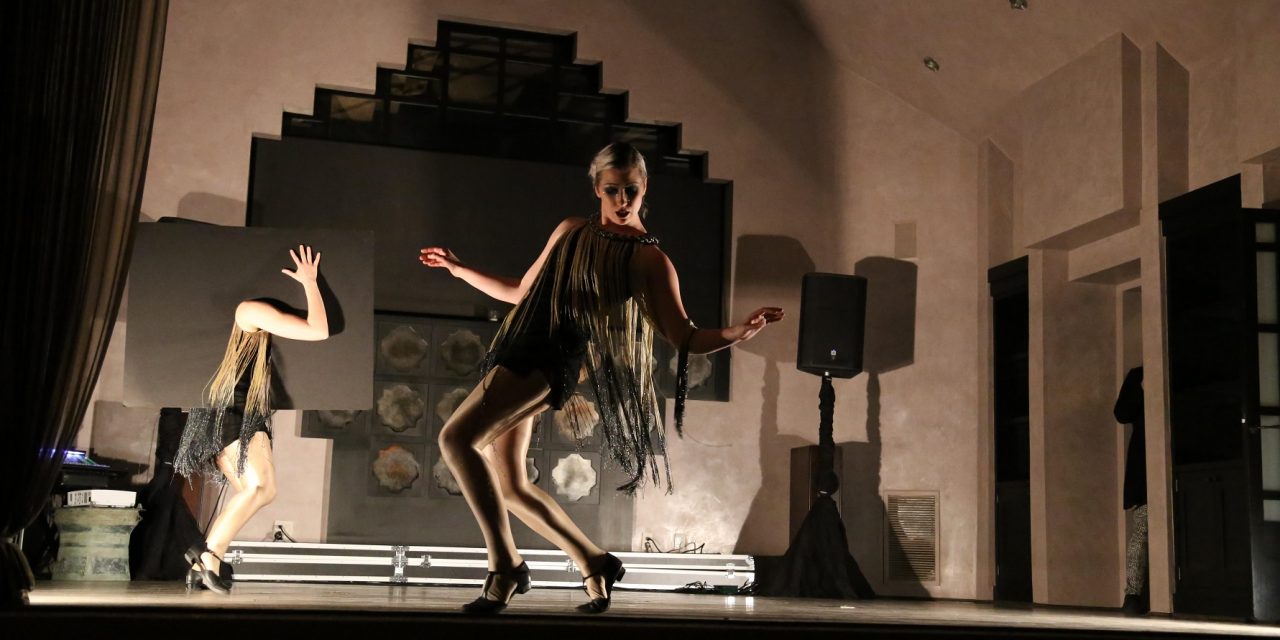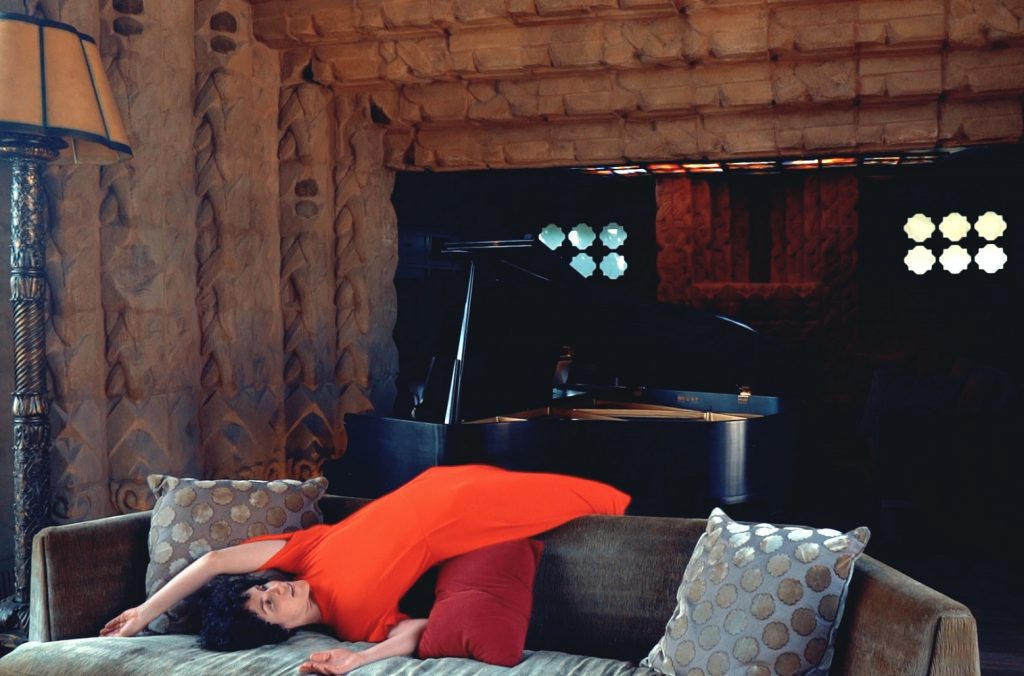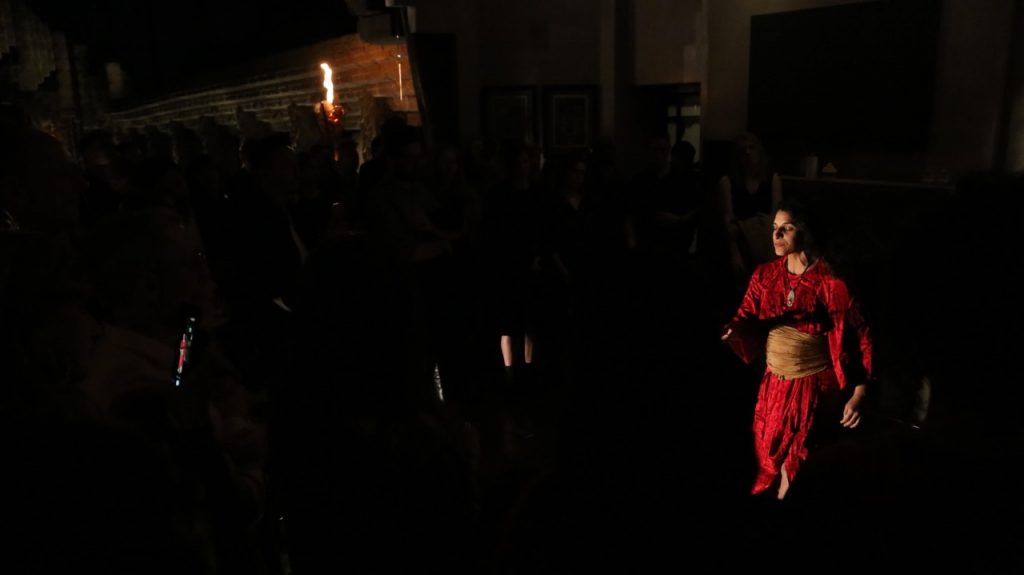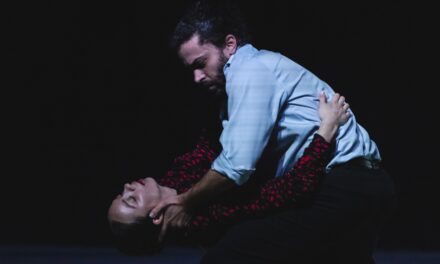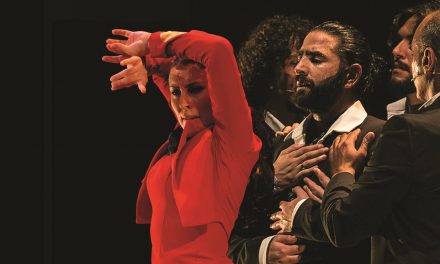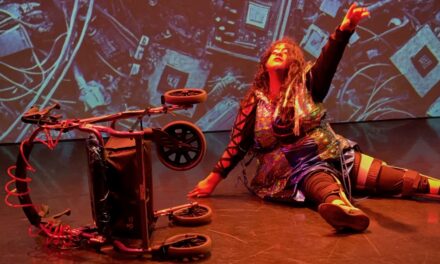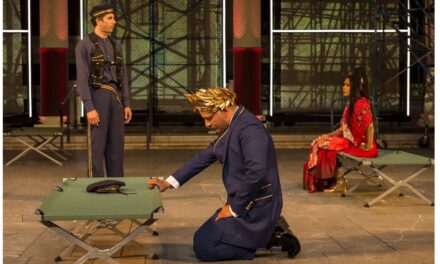On February 1, roughly one year after homeLA’s groundbreaking performance PASSAGES at the John Sowden House, the Los Feliz ghouls living within enticed the group to return to L.A.’s iconic architectural gem in order to host their Inaugural Benefit. There, the 7-year-old salon-style sight-specific dance company established by Rebecca Bruno put on a few highlights from their January 2019 show and played a video about their upcoming plans to transition into a more fully realized arts organization. In the coming year, they hope to more professionally document their ephemeral work, pay artists a living wage, and fund their Place-Making public youth education program.
Since its founding in 2013, the company, which labels itself as a nomadic performance project, has collaborated with over 120 interdisciplinary artists to briefly transform 20 private residences into artistic havens of dance, sound, video and sometimes, technology. The typically two-day runs involve plenty of episodic numbers that repeat throughout the course of each evening, with a few longer “main stage” acts peppered throughout the production. Recently, the company has expanded from small-scale homes to architectural landmarks, starting with their May 2017 show One House Twice at the Neutra VDL House in Silver Lake. The wildly successful night of immersive performance art was produced in partnership with ENTER>text — an artistic company that creates immersive reading installations, which carry a separate but similar vibe to Bruno’s work.
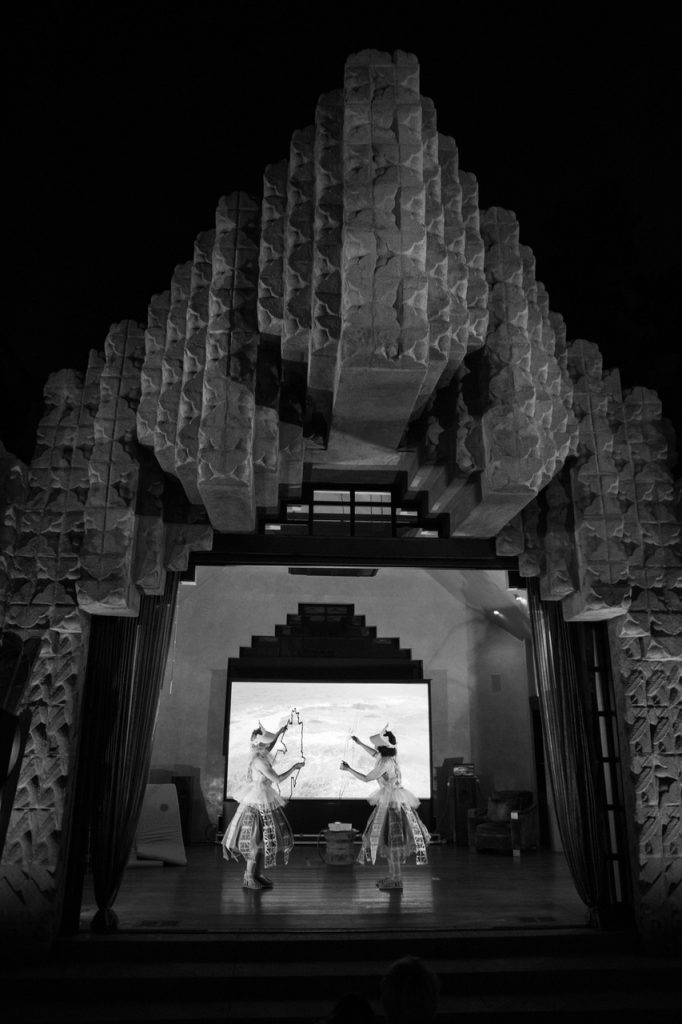
homeLA – Rebecca Bruno and Flora Wiegmann’s – “WEFT” in front of John Sowden House – Photo by Monika Sed
The Place-Making program would be an important next step for the company — an opportunity to take all of the knowledge they have acquired creating their site-specific work and passing it on to student dancers. Place-Making’s 12-week course aligns with high-school level Visual and Performing Arts requirements and is currently the only student-initiated dance class in site-specific dance in Los Angeles, if not the country. The free program is led by Samantha Mohr and Jay Carlon, with taisha paggett and Mara McCarthy on the advisory board — all longtime homeLA members and collaborators.
Interested parties could contribute through a variety of ways, including Venmo, the house’s gift store, and silent auctions of artwork and experience-based neighborhood packages. A video was played during the Benefit featuring Bruno asking for support and featuring images from previous shows. The most striking continue to come from last year’s PASSAGES.
PASSAGES was the ultimate embodiment of homeLA’s artistry, which grew to larger than life proportions at architect Lloyd Wright (son of the famous Frank Lloyd Wright)’s intimidating Mayan-inspired home. The house, which has long been closed off to the public, has an unsettling history of rowdy parties and seedy residents. Above all, it is best known for being the possible location of the Black Dahlia’s murder, so claimed by retired LAPD homicide detective Steve Hodel who wrote several books accusing his father, former Sowden resident — Dr. George Hodel, of the crime. (For more information about the Hodel family, primarily about George Hodel’s time at the home and his involvement in the cold case, I recommend the eight-episode podcast Root of Evil: The True Story of the Hodel Family and the Black Dahlia, hosted by Hodel’s great granddaughters Yvette Gentile and Rasha Pecoraro. Not for the faint of heart.)
Sowden House’s basement (where the murder(s) are presumed to have taken place) naturally remains out of bounds, but the courtyard, which was remodeled by previous-owner/designer Xorin Balbes in 2001 to incorporate a large swimming pool, and the open concept den and living rooms, which are part of the house’s original 1926 design are where most of the action once took and now continues to take place. homeLA gave attendees just a taste of their talent by whittling the 15-piece PASSAGES down to five. However, the routines remain strong, enhancing the house’s eerie vibe and structure primarily through movement.
Zaquia Mahler Salinas kicked off the timed performances with a recreation of the solo “Rest,” performed by Lauren Christie to melancholic music by James Carter, arranged/performed by Jonny Tarr. Dressed in black, she emerged dream-like and dancing along the pool’s edge until she found herself inching closer to the water with each balletic, contemporary swerve before easing her way toward the Jacuzzi. There she undressed down to her slip, then lowered herself into the basin until her face remains the only thing floating above the surface, eyes closed, in what resembled a suicide by way of drowning. Something about her stillness and demise continues to be reminiscent of the Black Dahlia having her life cut short. Although the circumstances and position in which they found Elizabeth Short’s body were much more theatrical, Salinas’s work feels like a representation of Short’s ghost mourning her own passing.
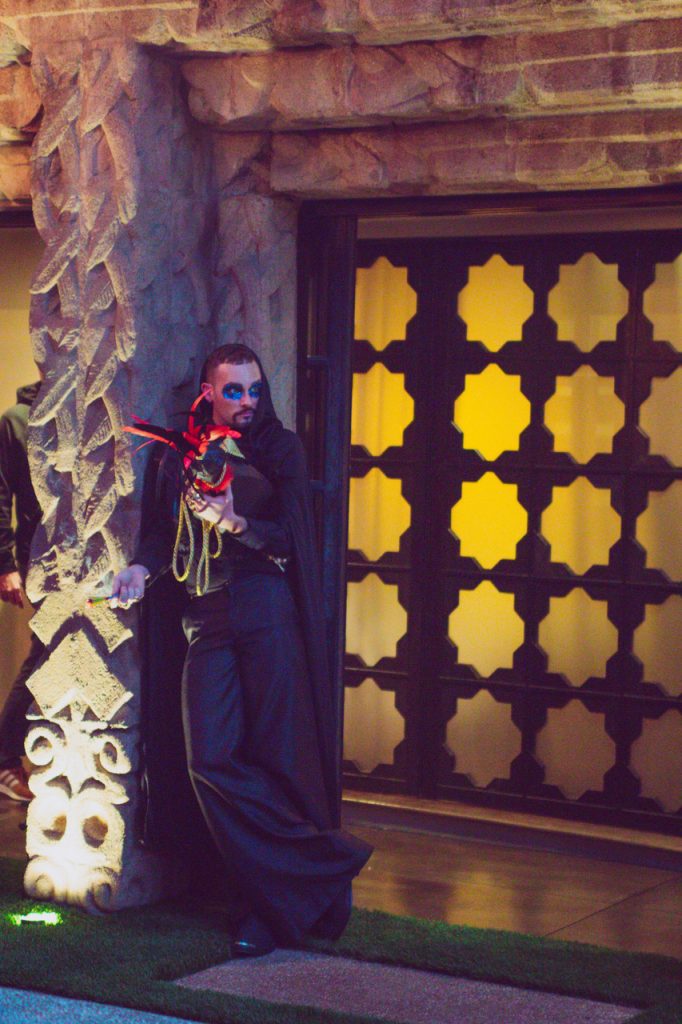
homeLA – Tyler Matthew Oyer in “Wait For Me at the Bottom of the Pool or Jack Goes to Hollywood” – Photo by Monika Sed
Tying into Salinas’s dance is the story of real-life Dominican actress and “Queen of Technicolor” Maria Montez, who accidentally drowned in her bathtub after having a sudden heart attack at the tender age of 39. Her death was fuel to Tyler Matthew Oyer’s portrayal of underground film director Jack Smith in his piece “WAIT FOR ME AT THE BOTTOM OF THE POOL OR JACK GOES HOLLYWOOD.” The work was virtually the same the second time around, if only slightly campier, further capturing the essence of Smith’s status as a never fully–realized star — much like Short. Oyer embodied Smith’s eccentricities by walking around the house carrying Yolanda, his Madonna bra–wearing stuffed penguin, and wearing sparkly eye shadow, while tickling audience members with feathers as they ate Mexican-inspired hors-d’œuvres (bites by Emily Marchand; sweets by Chef Taryn Garcia) and drank Mezcal (drinks provided by YOLA MEZCAL) poured in the home’s candle-holding votive souvenirs. He concluded his performance with a rant about all things Hollywood. How Smith would have loved to be a part of the in-crowd partying at the Sowden House back in the day. Yolanda’s placement on top of a giant lobster floaty, which he “films” with a bright smart device light, is the antithesis to Christine and Montez’s demise, and remains one of the comic and uplifting highlights of the evening.
One piece that changed dramatically was Odeya Nini’s “A Solo Voice”. Its transposition from the creepy stairwell to the “stage” — a hollowed-out den-like area located toward the back of the house — gave her low-toned whirring vocal piece new insight. Her viewership was able to grow due to the ample space and the acoustics were amplified. However, the loss of the laser pointer and dark, cave-like atmosphere she enjoyed during PASSAGES pulled away from the banshee-like feel she projected the first time around. Her vocals continued to astound however, and her self-mocking rendition of John Denver’s “Take Me Home, Country Roads” lightened the mood. Particularly when she replaced the lyrics “West Virginia” with “Los Angeles.” For us Angelenos, it seems all roads lead back to gothic locations such as the Sowden House.
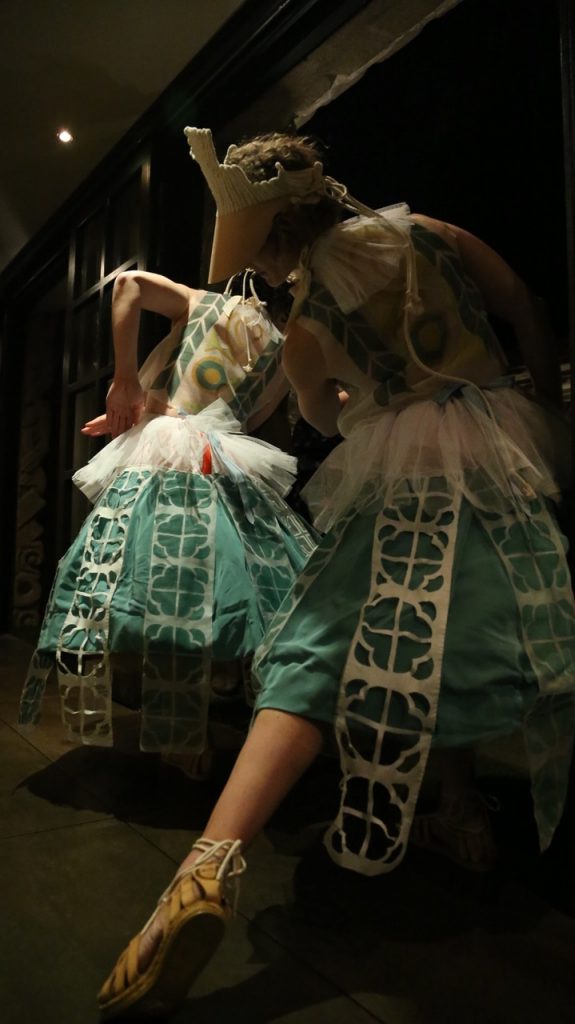
homeLA – Rebecca Bruno with Flora Wiegmann, Sam Widaman, and Lynne Ellen Bathke in “WEFT” – Photo by Andrew Mandinach
Bruno and Flora Wiegmann’s “WEFT” is an ode to their costumes (Lynn Ellen Bathke), which capture the design of the house’s walls, along with its Moroccan-style windows. Their woven crowns resemble the shape of the home’s balcony. The modern electric music (Sam Widaman) the duet march to felt stranger the first time around, but now appeared to tie in more closely with the contemporary paintings found hanging throughout the house — ones of hardboiled eggs and David Bowie in Aladdin Sane makeup. Their look is a sharp contrast to original owner John Sowden’s classic-looking paintings and photography. Bruno and Wiegmann honored the past and present with their energetic choreography and the incorporation of their hollowed outlines of what could be a Mayan god or the house’s blueprints, which they jutted upward, then wore like hula hoops. Bruno’s film ”D E U X” (made in collaboration with Delaram Pourábdi, founder of digital design company PARADEUX), was a sharp contrast to “WEFT.” The projection played on a loop above the koi pond in the master bathroom and featured dual images of Bruno falling over the ottoman and exploring the walk-in closet located opposite the spa. The mini movie conveying an overall more grounded feeling that saw a different side to the architecture.
Among the most effective pieces was the repeat of Cheng-Chieh Yu’s “Inservient,” featuring Sarah Jacobs, Darrian O’Reilly, and Yu. A bit like shades of flappers’ past, the specter-like women captured the spirit of all of the maladies that had infected the home since it was built. They greeted guests at the entrance by standing in the hallway forming shapes that resembled a Hindu deity — perhaps Shiva representing darkness and destruction. Throughout the evening, they moved in threes — dancing in the living room like an ominous version of Boticelli’s Primavera, pausing to stare into the pool, locking themselves up in a room with a giant aquarium while requiring viewer to watch through the windows as they filmed each other with a smart phone. Their presence seemed everywhere thanks to their hair/makeup tutorial, which played incessantly in the living room. They concluded by videoing each other in the courtyard spa, tempting themselves to fall into the Jacuzzi as they stuck parts of their limbs through a horseshoe cutout in a black cardboard and lowered them toward the water. They then performed a 1920s Charleston with the cardboard. The dismembered limbs and Marie Antoinette–like heads sticking through held a very close tie-in to the Black Dahlia’s hemicorporectomy (slicing in half). A creepy conclusion to the evening of movement.
Since the Benefit, the Place-Making pilot program experienced its first full week of activity after launching on February 3 at the A.B. Miller High School’s Level II Conservatory of Dance, led by Rosa R. Frazier and the Sam and Alfreda Maloof Foundation. During this time, Mohr set the foundation for the course by leading students through exercises that would help them explore the spaces and surfaces around them in relation to their bodies. Next week, they will have a site-visit at the Maloof Foundation, where they will be given a docent-led tour of the house and gardens in order to start planning the site-specific response work they’ll be developing for their March 21 performance.
With everything the company has accomplished and is now on their way to achieving, there is no doubt that they will reach great heights in the upcoming year and decade. The dances were a confirmation of all they have to offer the next generation, and a reaffirmation of their important mission to continue to shed light on Los Angeles’ history — a goal they’ll continue to achieve as long as they, like the Sowden House continue to evolve claim their presence within this city.
Written by Lara J. Altunian for LA Dance Chronicle, February
To visit the homeLA website, click here.
Featured image: homeLA – Cheng Chieh Yu with Sarah Jacobs and Darrian O’Reilly in “Inservient” – Photo by Andrew Mandinach

